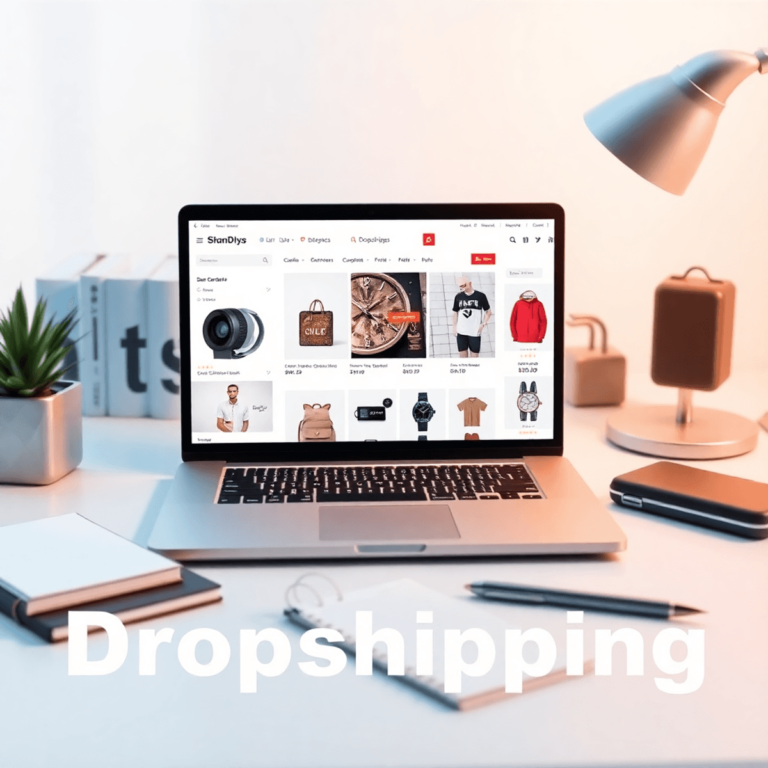
10 Essential Steps to Launching Your Dropshipping Business
The dropshipping business model has changed the way entrepreneurs approach e-commerce. It allows you to sell products without ever holding inventory, making it a low-risk way to start an online retail business. This makes it a popular choice for those looking to start a business with minimal upfront investment.
Dropshipping works by partnering with suppliers who handle storage, packaging, and shipping directly to your customers. This streamlined process means you can focus on marketing and growing your brand.
In this comprehensive dropshipping guide, you’ll discover the 10 essential steps to launching a successful dropshipping business. These steps provide a comprehensive path for anyone eager to learn how to dropship. Whether you’re seeking beginner dropshipping tips or looking to refine an existing strategy, this guide is designed to set you on the path to success in e-commerce.

1. Choose a Profitable Niche
Selecting the right niche is crucial in dropshipping. A profitable niche not only aligns with your interests but also meets high market demand, ensuring long-term success. Engaging with a niche you are passionate about keeps you motivated and allows for more authentic marketing strategies.
Steps to Researching a Dropshipping Niche
- Identify Your Interests
- Begin by listing areas that you are genuinely interested in or passionate about. This personal connection can provide insight into customer needs and product appeal.
- Research Market Demand
- Utilize tools like Google Trends to analyze current consumer trends and identify products with increasing interest. Tracking these patterns helps you pinpoint niches with potential growth.
- Conduct Competitor Analysis
- Examine successful competitors within your chosen niche to understand their strategies and product offerings. Analyze their strengths and weaknesses to uncover gaps in the market where you can differentiate your business.
By following these steps, you can effectively narrow down a profitable dropshipping niche that balances personal interest with market opportunity.
2. Find Reliable Suppliers
Sourcing products from trustworthy dropshipping suppliers, such as those found on platforms like Anstrex, is crucial for your business’s success. Partnering with reliable suppliers ensures product quality and consistent delivery times, which are vital for maintaining customer satisfaction.
When evaluating potential suppliers, consider the following factors:
- Product Quality: Request samples to assess the merchandise firsthand. This step helps ensure that the products meet your standards and those of your customers.
- Pricing: Compare prices among different suppliers to find competitive rates. Keep in mind that lower prices shouldn’t compromise quality.
- Customer Service Reliability: Test their responsiveness by reaching out with inquiries. Prompt and helpful replies indicate a supplier’s commitment to supporting your business needs.
Researching reviews and conducting sample orders provide valuable insights into a supplier’s reliability. Building strong relationships with reputable dropshipping suppliers can enhance your brand’s reputation and lead to long-term success in the e-commerce landscape.
3. Set Up Your E-Commerce Store
Building an eCommerce store is a crucial step in launching your dropshipping business. Selecting the right platform can significantly impact your store’s functionality and ease of use. Popular choices include Shopify and WooCommerce, both known for their user-friendly interfaces and extensive customization options.
To get started, follow this step-by-step guide:
- Choose a Domain Name: Select a memorable and relevant domain name that reflects your brand identity.
- Secure Web Hosting: Depending on your chosen platform, you may need to set up web hosting. Services like Bluehost or SiteGround are suitable for WooCommerce, while Shopify handles hosting internally.
- Platform Setup:
- Shopify: Simply sign up, choose a template, and customize it to fit your brand.
- WooCommerce: Install WordPress, add the WooCommerce plugin, and configure essential settings.
- Integrate Payment Gateways: Enable payment methods such as PayPal or Stripe to facilitate smooth transactions for your customers.
This foundational setup ensures your online store is ready to showcase products and begin processing orders efficiently.
4. Register Your Dropshipping Business Legally
Legal registration is a crucial step for your dropshipping venture, offering protection and establishing credibility. Without proper registration, you risk legal complications that could affect your business operations.
Choosing the right business structure is essential. Here are some options:
- Sole Proprietorship: Simplest to set up, but personal assets are not protected against business liabilities.
- Limited Liability Company (LLC): Offers liability protection, separating personal and business assets, though it may involve more paperwork and fees.
Consider factors like liability protection, tax implications, and administrative requirements when deciding. Consulting with a legal professional can provide clarity tailored to your specific situation.
Once you’ve selected a structure, proceed to officially register your business with the appropriate government bodies. This often includes obtaining a tax identification number (TIN) and any necessary permits or licenses relevant to your industry and location.
5. Organize Your Finances for Success
Effectively managing your finances is a cornerstone of any thriving dropshipping business. Separating personal and business finances is not just a best practice; it’s essential for long-term growth and sound financial management. This separation provides clarity, simplifies accounting, and reduces potential legal complications.
To set up finances for a dropshipping business:
- Open a dedicated business bank account: This step ensures that all business transactions are kept distinct, which aids in easier tracking of income and expenses.
- Obtain necessary permits and tax IDs: Depending on your location, you may need specific permits or licenses. Acquiring a tax identification number is crucial for tax compliance.
- Utilize accounting software: Tools like QuickBooks or Xero can help maintain organized records. They assist in tracking expenses, generating financial reports, and ensuring tax readiness.
By implementing these strategies, you create a solid financial foundation, positioning your business for success and sustainability.
6. Develop a Winning Marketing Strategy
Building a strong marketing strategy is essential for the success of your dropshipping business. A comprehensive approach should include both paid advertising and organic strategies.
Paid Advertising
Paid advertising, such as Facebook ads, allows you to target specific demographics and quickly drive traffic to your store. These platforms offer advanced targeting options, enabling you to reach potential customers who are most likely to be interested in your products.
Organic Strategies
On the organic side, content marketing plays a crucial role. Creating valuable content like blog posts or videos that answer common questions or provide insights about your niche can organically attract visitors. This not only boosts your site’s SEO but also builds trust with your audience.
Leveraging social media influencers can further amplify your reach. Collaborate with influencers within your niche who resonate with your target audience. Their endorsement can bring credibility and visibility to your products, enhancing your brand’s presence in the competitive dropshipping landscape.
It’s also important to stay updated with the latest trends in the industry. For instance, if you’re considering expanding your dropshipping business to platforms like Amazon, here’s a comprehensive guide that outlines the steps to successfully start a dropshipping business on Amazon in 2024.
Engaging these strategies will optimize marketing efforts, effectively driving growth and sales in your venture.
7. Analyze Competitors to Stay Ahead
Conducting a competitor analysis in dropshipping is crucial for gaining insights into the successful strategies employed by others within your niche. Here’s how you can approach this:
- Research Competitors: Use tools like SEMrush or Ahrefs to identify key players in your market. Look at their product range, pricing strategies, and marketing tactics.
- Identify Successful Techniques: Examine their customer engagement methods and promotional activities. Notice what works well for them, such as specific advertising channels or content formats that attract significant attention.
- Discover Unique Selling Points (USPs): Determine areas where you can stand out. This might include offering unique product features, superior customer service, or competitive pricing options that are currently unmet by others.
- Spot Untapped Opportunities: Explore potential gaps in the market that competitors haven’t addressed. Consider niche subcategories or emerging trends that could give you an edge.
Understanding these elements empowers you to carve out a unique position in the marketplace, ensuring your business remains competitive and innovative.
8. Optimize Your E-Commerce Store for Conversions
Achieving high conversion rates starts with effective SEO for dropshipping businesses. By optimizing product pages and blog posts, you enhance visibility in search engine results pages (SERPs), driving organic traffic to your store. Use relevant keywords naturally within titles, descriptions, and content to improve search rankings.
Equally crucial is enhancing the user experience. A well-designed store layout with intuitive navigation guides visitors seamlessly through your site. Ensure mobile responsiveness, as a significant portion of online shopping occurs on mobile devices. High-quality images and videos can showcase your products compellingly, providing customers with a clear understanding of what they’re purchasing.
Incorporating these elements not only attracts more visitors but converts them into loyal customers. Tailoring your e-commerce store to meet both SEO standards and user expectations is a strategic approach that sets the foundation for sustained growth in the competitive landscape of dropshipping.
9. Prioritize Exceptional Customer Support Experience
Customer support in dropshipping plays a crucial role in building trust and encouraging repeat business. Establishing clear communication channels is essential. Utilize tools like Zendesk or Gorgias for live chat and email automation to ensure timely responses and effective issue resolution.
1. Live Chat & Email Automation
Implement systems that allow customers to reach out at any time, offering prompt assistance and reducing the wait time for solutions.
2. Comprehensive Product Descriptions
Clearly outline product specifications, benefits, and usage instructions. Address common questions or hesitations upfront to minimize customer uncertainty.
By focusing on these aspects, you enhance the overall user experience, fostering positive relationships with your customers and setting your dropshipping business apart from competitors.
10. Continuously Learn from Data Insights & Iterate Your Strategy Over Time!
In the ever-changing world of dropshipping, making decisions based on data is crucial for success. By regularly analyzing sales data and customer behavior patterns, you can gain valuable insights into what strategies are effective and what areas need improvement.
Use Analytics Tools for Deeper Insights
Utilizing analytics tools like Google Analytics, Hotjar, or Optimizely can help you pinpoint areas needing improvement. These tools offer a wealth of information:
- Sales Data Analysis: Identify which products are top-sellers and which are underperforming. This can guide your inventory decisions.
- Customer Behavior Patterns: Understand how customers navigate your site, where they drop off, or which pages hold their attention.
- Ad Campaign Optimization: Recognize ads that aren’t yielding desired results and adjust strategies to maximize ROI.
Refine Your Strategies Based on Insights
Continuous learning from these insights allows you to refine your marketing tactics, enhance user experience, and ultimately drive more conversions. Staying responsive to data keeps your business agile and competitive in the marketplace.
Conclusion: Start Your Dropshipping Journey Today!
Starting your own dropshipping business opens doors to a world of eCommerce opportunities. With the knowledge from this guide, you’re ready to learn how to start a successful dropshipping business. Embrace the journey ahead with confidence, knowing each step you take is a stride toward success. Whether you’re curious about how to dropship or eager to dive into how to start dropshipping, your path is clear. Take action today, and watch your eCommerce dreams unfold!


